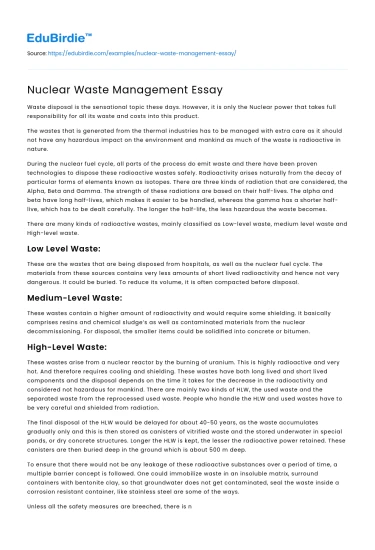Waste disposal is the sensational topic these days. However, it is only the Nuclear power that takes full responsibility for all its waste and costs into this product.
The wastes that is generated from the thermal industries has to be managed with extra care as it should not have any hazardous impact on the environment and mankind as much of the waste is radioactive in nature.
Save your time!
We can take care of your essay
- Proper editing and formatting
- Free revision, title page, and bibliography
- Flexible prices and money-back guarantee
During the nuclear fuel cycle, all parts of the process do emit waste and there have been proven technologies to dispose these radioactive wastes safely. Radioactivity arises naturally from the decay of particular forms of elements known as isotopes. There are three kinds of radiation that are considered, the Alpha, Beta and Gamma. The strength of these radiations are based on their half-lives. The alpha and beta have long half-lives, which makes it easier to be handled, whereas the gamma has a shorter half-live, which has to be dealt carefully. The longer the half-life, the less hazardous the waste becomes.
There are many kinds of radioactive wastes, mainly classified as Low-level waste, medium level waste and High-level waste.
Low Level Waste:
These are the wastes that are being disposed from hospitals, as well as the nuclear fuel cycle. The materials from these sources contains very less amounts of short lived radioactivity and hence not very dangerous. It could be buried. To reduce its volume, it is often compacted before disposal.
Medium-Level Waste:
These wastes contain a higher amount of radioactivity and would require some shielding. It basically comprises resins and chemical sludge’s as well as contaminated materials from the nuclear decommissioning. For disposal, the smaller items could be solidified into concrete or bitumen.
High-Level Waste:
These wastes arise from a nuclear reactor by the burning of uranium. This is highly radioactive and very hot. And therefore requires cooling and shielding. These wastes have both long lived and short lived components and the disposal depends on the time it takes for the decrease in the radioactivity and considered not hazardous for mankind. There are mainly two kinds of HLW, the used waste and the separated waste from the reprocessed used waste. People who handle the HLW and used wastes have to be very careful and shielded from radiation.
The final disposal of the HLW would be delayed for about 40-50 years, as the waste accumulates gradually only and this is then stored as canisters of vitrified waste and the stored underwater in special ponds, or dry concrete structures. Longer the HLW is kept, the lesser the radioactive power retained. These canisters are then buried deep in the ground which is about 500 m deep.
To ensure that there would not be any leakage of these radioactive substances over a period of time, a multiple barrier concept is followed. One could immobilize waste in an insoluble matrix, surround containers with bentonite clay, so that groundwater does not get contaminated, seal the waste inside a corrosion resistant container, like stainless steel are some of the ways.
Unless all the safety measures are breeched, there is no way that these wastes would cause harm to mankind , as this is the only waste that has been and will be treated carefully and responsibly.






 Stuck on your essay?
Stuck on your essay?

